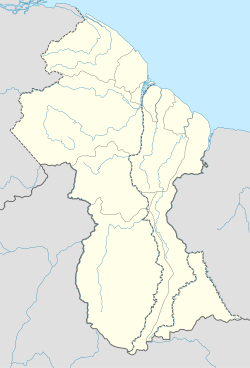| Kabakaburi Village | |
|---|---|
| Amerindian Village | |
 Entrance to Kabakaburi Village from the Pomeroon River Entrance to Kabakaburi Village from the Pomeroon River | |
 | |
| Coordinates: 7°14′45″N 58°43′48″W / 7.24583°N 58.73000°W / 7.24583; -58.73000 | |
| Country | |
| Region | Pomeroon-Supenaam |
| Kabakaburi | 1845 |
| Founded by | William Henry Brett |
| Government | |
| • Toshao | Monty Simon (2021) |
| Population | |
| • Total | 464 |
| Time zone | UTC-4 |
Kabakaburi is an Amerindian village in the Pomeroon-Supenaam Region of Guyana on the Pomeroon River, 56 km (35 mi) from its mouth. The village was founded in 1845 by William Henry Brett on the location where Fort Durban used to be.
The name of the village is Arawak for "the place with the itching bush." The "bush" referred to is a wild arum (Dieffenbachia paludicola) having irritating juice. The Arawak named this plant "jotoro", and named the place where it grew "kabo kabura." Over time, this became Kabakaburi.
The village has four subdivisions; Macaseema, Waiwaro, the Mission (Kabakaburi), and Aripiaco.
History
According to Brett's travelogue, Kabakaburi (Cabacaburi) was a hill owned by the Arawak and established as a settlement for wood-cutting. It was abandoned in 1843 until purchased by the first bishop of Guiana for use as a mission, and the village was settled by Kalina people in addition to Arawak. In 1858, the chapel Brett founded at the confluence of the Pomeroon and the Arapaiaco Rivers has deteriorated so much that it was moved to high ground at Kabakaburi.
Economy
The villagers are mostly Arawak and Carib. Many of them work in the area's logging and mining industries. As many as 60% of the residents rely on the logging industry and agriculture is challenged by regular flooding of the Pomeroon River.
The Kabakaburi Handicraft Association was founded in 1994 for community members, including training and a location for production, storage, and selling of handicraft items.
Services
Kabakaburi has a primary school, health centre, and sports hall. A new library, located in the Kabakaburi Primary School, was created in 2020.
The village mainly relies on gas-run generators for electricity and a 65 kW lighting system that was installed in 2012.
References
- Regional Democratic Council, Region 2 (11 May 2021). "The Ministry of Amerindian Affairs extends Congratulations to Mr. Monty Simon on being elected as the New Toshao..." Facebook.
{{cite web}}: CS1 maint: numeric names: authors list (link) - "2012 Population by Village". Statistics Guyana. Retrieved 16 August 2020.
- ^ "Kabakaburi – Amerindian Heritage Festival 2010". Kaieteur News Online. 3 October 2010. Retrieved 14 September 2020.
- "People, places… Kabakaburi: Home to the most vibrant bamboo industry". Guyana Chronicle. Retrieved 17 August 2020.
- ^ Blair, Niebert; Pons, Dirk; Krumdieck, Susan (January 2019). "Electrification in Remote Communities: Assessing the Value of Electricity Using a Community Action Research Approach in Kabakaburi, Guyana". Sustainability. 11 (9): 2566. doi:10.3390/su11092566.
- Brett, Rev W. H. (1868). The Indian Tribes Of Guiana. pp. 163–165, 246–247.
- "Toshao says Kabakaburi feeling squeeze after GFC halts logging operations". Stabroek News. 2017-08-11. Retrieved 2021-03-07.
- "CDC distributes relief supplies to flood-hit Pomeroon residents". Stabroek News. 2021-01-09. Retrieved 2021-03-07.
- Ousman, Sharon; MacQueen, Duncan; Roberts, Grace (2006). Stronger by Association: Lessons from Guyana's Forest-based Associations. IIED. pp. 33–36. ISBN 978-1-84369-615-5.
- "New stelling launched at Ykinipa". Stabroek News. 2017-12-18. Retrieved 2021-03-07.
- "ESG". Eco Oil and Gas. Retrieved 17 August 2020.
External links
 Media related to Kabakaburi at Wikimedia Commons
Media related to Kabakaburi at Wikimedia Commons